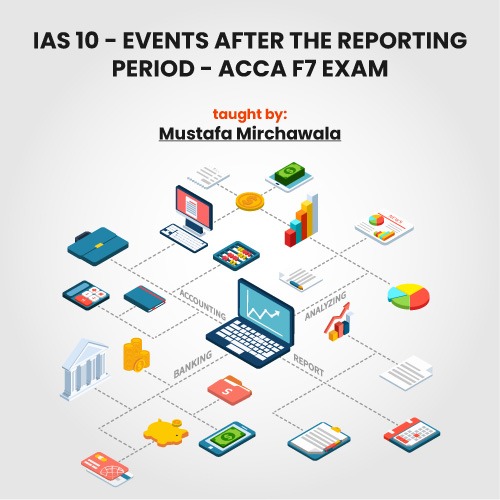“Master IAS 10 – Your ACCA F7 Exam Success with Events after the Reporting Period!”
IAS 10- Events After The Reporting Period
This article was provided by Mirchawala’s Hub Of Accountancy; please visit our website Mirchawala.com for more educational blogs about ACCA in the UAE – India – Nepal- Gulf and subcontinent.

The foremost objective of financial statements
“The objective of financial statements is to provide information about the financial position, performance, and changes in the financial position of an enterprise that is useful to a wide range of users in making economic decisions.” Financial statements should be understandable, relevant, reliable, and comparable. The most important objective of the financial statement is to provide information to relevant users ie shareholders
Characteristics of useful information
This is the most basic topic that ACCA students have studied multiple times in their applied knowledge exams. Now before moving further to international accounting standards. Let us revise the basics to hold more grip on advanced topics. Because this IAS is not only studied. Under financial accounting paper but is also highly relevant for applied knowledge and professional students of ACCA.
There are five traits that you’ll find within data quality: accuracy, completeness, reliability, relevance, and timeliness. The one most related to this IAS is timeliness. if at the correct time, the financial statements are not presented to the shareholders or relevant users then such information is of no use.
Why do times matter the most? because after evaluating the financial statements, presented to the relevant user, a lot of strategic decisions are made that overall impact the financial position of the Company.
After the accounting period ends, the financial statements are not presented to shareholders at the same time because those financial statements get time to be approved and signed. Now during this duration the company might receive information related to that year which should be amended in those accounts that are under approval and have not yet been presented to shareholders all the accounting period has ended.
So before presenting those statements how to deal with the new information?
What Does This IAS Deals With?
Continuing the above, this IAS deals with whether to adjust the relevant information received after the reporting period or not to adjust it in that year’s accounts. These two conditions are classified as adjusting and non-adjusting events. Now which event to adjust and which event to not, is determined by International Accounting Standard 10. Remember we cannot account for this new information after the reporting period into next year’s financial statement. think to yourself such information relevant to shareholders now will be presented to them after one whole year. this is against the international accounting standard board.
Note: which information will be dealt with under IAS 10. the board has set certain times for it. all that information that we receive between the reporting period end date and the date on which the financial statement got approved. The information received before the reporting date will obviously be accounted for in that year’s financial statement and the information received after the date of approval will be accounted for in the next financial statement. Let’s understand the adjusting and non-adjusting events in detail along with their practical example
Identification of adjusted or non-adjusted event
The question that is usually asked at this level is how students will identify and discriminate between adjusted and non-adjusted events. so that they know for which event they need to make an entry and for which event only disclosure is required
Adjusting events in IAS 10
All those events after the reporting period but before the approval date which will be recognized in last year’s statement are known as adjusting events. although they occurred after the accounting period the chances of their occurrences were there before the reporting date. for these events, a proper entry would be made to incorporate the effect of such events into the financial statements.
Bad debts – Adjusting events
Whenever we do credit sales there is always a credit risk. After the reporting period, it was virtual that one of our receivables would not pay us now and would be considered a defaulter. although the due date of payment was 20 days before the reporting period. now at the reporting period the condition existed that we will have to write off this receivable therefore this will considered an adjusting event
Inventory selling at lower cost – Adjusting events
For example, at the year’s end due to some operational problems, our inventory got damaged and now will be sold for less than its cost After the reporting period the inventory got sold for a very low value even lower than the cost, now this will be called adjusting event because the event that led the value to decrease happened before and there were chances that now our inventory will be sold for a lower value. hence the effect of such a transaction would be accounted for in the financial statements. if the value of the inventory decreases due to any event that occurred between the reporting date and signed off date then it is a non-adjusting event. If the condition didn’t exist in between these days then it is indicating that the value of inventory was affected before the reporting date, hence adjusting the event
Examiners testing: there might be one question in which there are both adjusting and non-adjusting events. do practice such questions before you attempt! Watch the video below to see the proper calculations done by Mustafa Mirchawala.
Fraud discovered after the year-end, existed at SOFP date- Adjusting event
Fraud was being done in the organization but no one figured it out before the reporting date. now after the reporting date, the company discovered the fraud which means the year-end financial statements are not true and fair, hence there will be amendments in the books and this is considered to be adjusting events
Court case outstanding at the year-end-adjusting events
Before the year-end, the company sold some goods, somehow those goods were defective which affected the health of the company’s customers and now the case was filed against the company and to compensate for this the company has to pay a certain amount. now these charges are paid after the reporting date, the chances of outflow existed at the year-end indicating that chances of occurrence existed at the year-end and hence would be classified as an adjusting event
Determination of bonus after the year-end adjusting event
In most organizations to boost employee motivation and expectancy, performance-related pay is given which might be set as a certain percentage of profit. now profits are determined after some time of the reporting date but the pay is based on the performance did by them last year, therefore, it is considered to be an adjusting event. here the concept of matching principle is being applied because the bonus is our expense and expenses are recorded when they are incurred
Non-Adjusting Events in IAS 10
Events that happened after the reporting date and before the sign-off date but the condition of such events do not exist at the year-end. In the case of the non-adjusting event, only disclosure is required and no accounting entry would be made to account for its effect. disclosure is only required too with the condition that the transaction should be material. no disclosure is required if a transaction is small. the trick to identifying non-adjusting events is to think that all those events that happened immediately with no expectations are non adjusting
Some examples of non-adjusting events are
- After year end any asset classified as held for sale
- Stock burnt
- Earthquake
- Sudden fall in the value of investment
- Strike by labor after Year-end
- Issue of new shares
- Issue of loan notes
- Dividend declared after the year-end
These will be accounted for in next year’s financial statement
How to deal with dividends
Once dividends are declared in the annual general meeting then it become the current liability of the company. if declared before the reporting date then the obligation is there therefore you will book the liability. you will book retained earning debit and dividend payable credit
If declared after the year-end
They will always be accounted for as non adjusting events. why? because at the year’s end, the dividends were not declared hence no obligation was there at the year’s end. so this will not be adjusted in the financial statements. The second reason is that we are not obliged to pay dividends to ordinary shareholders
Dividends proposed/declared
In practical life, after the year’s end, there is accounts preparation and then the meeting is held. two things that are evaluated in the meeting are the retained earnings and cash flows of the companies by directors. based on these two factors, it is decided whether the dividends should be paid or not. Now to this day, it is just recommendations and on this basis, no entry is made.
After this, the accounts are sent to shareholders and then the annual general meeting is arranged, at this meeting both directors and shareholders are present and then they evaluate different things through voting. among all these different things one of them is dividend proposal. This dividend proposal was set by directors earlier but now at the annual general meeting through voting shareholders agree or disagree with the dividend proposed by the directors. If the dividend proposed surpasses the voting and wins a majority of votes then on this day dividend is declared and now the company is obliged to pay dividends. although no entry is made for dividends proposed the dividend declared will be booked as a liability in the company books of accounts.
How going concern is treated over here?
Now let us get to going concern, An entity is a going concern unless management either intends to liquidate the entity or cease trading or has no realistic alternative but to do so (IAS 1.25). This means companies usually make accounts with the assumption that the company will last for plenty of years and it will be an ongoing business. Going concern is an accounting term, which means a business is financially stable and can operate with the expectation of indefinite existence.
For example, before year-end, the company was well established with billions of dollars in revenue, and after the year-end out of nowhere, the company was no longer financially sound. Now in such case IAS 10 tells us that if the company’s going concern status is disturbed after the year-end it will always be considered as an adjusting event whether or not the condition existed at the date of SOFP When going concern of the company is affected then accounts are made at breakup basis. everything will be realised and paid.
Frequently asked questions
Q1. What are the five characteristics of useful information in financial statements?
The five characteristics are accuracy, completeness, reliability, relevance, and timeliness, with timeliness being particularly relevant to IAS 10.
Q2. What is the primary focus of IAS 10, Events After the Reporting Period?
IAS 10 deals with whether to adjust or not to adjust relevant information received after the reporting period into that year’s accounts, distinguishing between adjusting and non-adjusting events.
Q3. How are bad debts typically treated in relation to adjusting events?
Bad debts are considered adjusting events
Q4. What is the key criterion for an event to be classified as an adjusting event?
An event is classified as an adjusting event if the condition leading to it existed at the reporting date.
Q5. Can you give an example of a non-adjusting event?
One example is an earthquake that occurs after the reporting date but was not anticipated or expected before that date.
Q6. How are dividends declared after the year-end treated in financial statements?
dividends declared after the year-end are treated as non-adjusting events .
Q7. What is the concept of going concern in accounting?
Going concern is the assumption that an entity will continue to operate and remain financially stable for the foreseeable future. It means that accounts are prepared with the expectation of the company’s indefinite existence.
Q8. How does IAS 10 treat a disturbed going concern status?
If the going concern status is disturbed after the year-end, IAS 10 considers it an adjusting event and financial statements are prepared on a breakup basis
Written by Warisha Shehzadi – student of Mirchawala Hub Of Accountancy








[…] What establishes the Necessity of IFRS 13? The International Read more September 30, […]
[…] establishes the Necessity of IFRS 13? The International Financial Read more September 30, […]
[…] establishes the Necessity of IFRS 13? The International Financial Read more September 30, […]
Comments are closed.